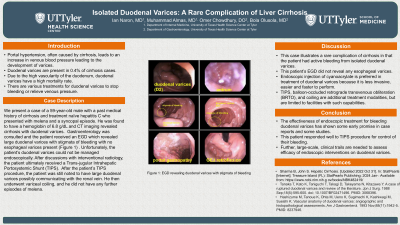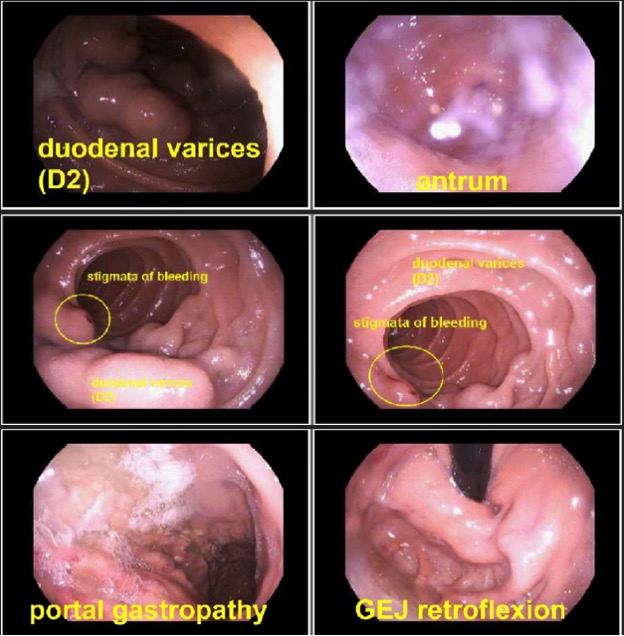Monday Poster Session
Category: GI Bleeding
P2483 - Isolated Duodenal Varices: A Rare Complication of Liver Cirrhosis
Monday, October 28, 2024
10:30 AM - 4:00 PM ET
Location: Exhibit Hall E

Has Audio
- IN
Ian Naron, MD
University of Texas Health Science Center
Tyler, TX
Presenting Author(s)
Ian Naron, MD1, Muhammad Almas, MD2, Omer Chowdhury, DO1, Bolarinwa Olusola, MD3
1University of Texas Health Science Center, Tyler, TX; 2University of Texas Health Sciences Center, Tyler, TX; 3University of Texas Health East Texas Physicians, Tyler, TX
Introduction: Cirrhosis is characterized by fibrotic changes in the liver that can lead to various complications including hepatic encephalopathy, gastroesophageal varices, and rarely duodenal varices. Portal hypertension, often caused by cirrhosis, leads to an increase in venous blood pressure leading to the development of varices. Previous studies have found duodenal varices to be present in 0.4% of cirrhosis cases. Due to the high vascularity of the duodenum, duodenal varices have a high mortality rate. There are various treatments for duodenal varices to stop bleeding or relieve venous pressure.
Case Description/Methods: We present a case of a 59-year-old male with a past medical history of cirrhosis and treatment naïve hepatitis C who presented with melena and a syncopal episode. He was found to have a hemoglobin of 6.8 g/dL and CT imaging revealed cirrhosis with duodenal varices. Gastroenterology was consulted and the patient received an EGD which revealed large duodenal varices with stigmata of bleeding (Figure 1). Unfortunately, the patient’s duodenal varices could not be managed endoscopically. After discussions with interventional radiology, the patient ultimately received a Trans-jugular Intrahepatic Portosystemic Shunt (TIPS). After the patient’s TIPS procedure, the patient was still noted to have large duodenal varices possibly communicating with the renal vein. He then underwent variceal coiling, and he did not have any further episodes of melena.
Discussion: This case illustrates a rare complication of cirrhosis in that the patient had active bleeding from isolated duodenal varices. Endoscopic injection of cyanoacrylate is preferred in treatment of duodenal varices because it is less invasive, easier and faster to perform. However, cyanoacrylate is not available at our institution. The effectiveness of endoscopic treatment for bleeding duodenal varices has been limited to only case reports and some studies have shown variable results. Radiologic intervention such as TIPS, balloon-occluded retrograde transvenous obliteration (BRTO), and coiling are additional treatment modalities, but are limited to facilities with such capabilities. Our patient had a good response with TIPS and coiling. Further large scale, prospective, RCTs are needed to validate efficacy of endoscopic interventions on duodenal varices.

Disclosures:
Ian Naron, MD1, Muhammad Almas, MD2, Omer Chowdhury, DO1, Bolarinwa Olusola, MD3. P2483 - Isolated Duodenal Varices: A Rare Complication of Liver Cirrhosis, ACG 2024 Annual Scientific Meeting Abstracts. Philadelphia, PA: American College of Gastroenterology.
1University of Texas Health Science Center, Tyler, TX; 2University of Texas Health Sciences Center, Tyler, TX; 3University of Texas Health East Texas Physicians, Tyler, TX
Introduction: Cirrhosis is characterized by fibrotic changes in the liver that can lead to various complications including hepatic encephalopathy, gastroesophageal varices, and rarely duodenal varices. Portal hypertension, often caused by cirrhosis, leads to an increase in venous blood pressure leading to the development of varices. Previous studies have found duodenal varices to be present in 0.4% of cirrhosis cases. Due to the high vascularity of the duodenum, duodenal varices have a high mortality rate. There are various treatments for duodenal varices to stop bleeding or relieve venous pressure.
Case Description/Methods: We present a case of a 59-year-old male with a past medical history of cirrhosis and treatment naïve hepatitis C who presented with melena and a syncopal episode. He was found to have a hemoglobin of 6.8 g/dL and CT imaging revealed cirrhosis with duodenal varices. Gastroenterology was consulted and the patient received an EGD which revealed large duodenal varices with stigmata of bleeding (Figure 1). Unfortunately, the patient’s duodenal varices could not be managed endoscopically. After discussions with interventional radiology, the patient ultimately received a Trans-jugular Intrahepatic Portosystemic Shunt (TIPS). After the patient’s TIPS procedure, the patient was still noted to have large duodenal varices possibly communicating with the renal vein. He then underwent variceal coiling, and he did not have any further episodes of melena.
Discussion: This case illustrates a rare complication of cirrhosis in that the patient had active bleeding from isolated duodenal varices. Endoscopic injection of cyanoacrylate is preferred in treatment of duodenal varices because it is less invasive, easier and faster to perform. However, cyanoacrylate is not available at our institution. The effectiveness of endoscopic treatment for bleeding duodenal varices has been limited to only case reports and some studies have shown variable results. Radiologic intervention such as TIPS, balloon-occluded retrograde transvenous obliteration (BRTO), and coiling are additional treatment modalities, but are limited to facilities with such capabilities. Our patient had a good response with TIPS and coiling. Further large scale, prospective, RCTs are needed to validate efficacy of endoscopic interventions on duodenal varices.

Figure: Figure 1: EGD revealing duodenal varices with stigmata of bleeding
Disclosures:
Ian Naron indicated no relevant financial relationships.
Muhammad Almas indicated no relevant financial relationships.
Omer Chowdhury indicated no relevant financial relationships.
Bolarinwa Olusola indicated no relevant financial relationships.
Ian Naron, MD1, Muhammad Almas, MD2, Omer Chowdhury, DO1, Bolarinwa Olusola, MD3. P2483 - Isolated Duodenal Varices: A Rare Complication of Liver Cirrhosis, ACG 2024 Annual Scientific Meeting Abstracts. Philadelphia, PA: American College of Gastroenterology.
